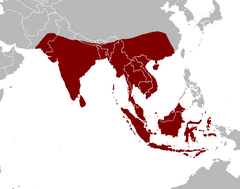Pangasiidae
| Pangasiidae[1] | |
| Bleeker, 1858 | |
 Przedstawiciel rodziny – Pangasius larnaudii | |
| Systematyka | |
| Domena | eukarionty |
| Królestwo | zwierzęta |
| Typ | strunowce |
| Podtyp | kręgowce |
| Nadgromada | kostnoszkieletowe |
| Gromada | promieniopłetwe |
| Podgromada | nowopłetwe |
| Infragromada | doskonałokostne |
| Nadrząd | otwartopęcherzowe |
| Rząd | sumokształtne |
| Rodzina | Pangasiidae |
| Typ nomenklatoryczny | |
Pangasius Valenciennes, 1840 | |
| Zasięg występowania | |
 Zasięg występowania rodziny Pangasiidae | |
Pangasiidae – rodzina słodkowodnych ryb sumokształtnych (Siluriformes), w języku polskim nazywanych sumami wędrownymi[2]. Obejmuje ok. 30 gatunków.
Zasięg występowania
Azja Południowa i Południowo-Wschodnia, od Pakistanu po Borneo[3].
Cechy charakterystyczne
U większości gatunków występują dwie pary wąsików (szczękowe i jedna para żuchwowych lub podbródkowych; nosowe nigdy nie występują). Ciało spłaszczone; obecna mała płetwa tłuszczowa, nigdy niezrośnięta z płetwą ogonową; płetwa grzbietowa przesunięta daleko do przodu, z jednym lub dwoma kolcami i 5–7 miękkimi promieniami; płetwa odbytowa z 26–46 promieniami; 39–52 kręgów. Pangasianodon gigas osiąga maksymalną długość około 3 m, przy masie ciała ok. 300 kg[3].
Klasyfikacja
Rodzaje zaliczane do tej rodziny[4]:
- Helicophagus
- Pangasianodon
- Pangasius
- Pseudolais
oraz wymarły rodzaj †Cetopangasius i 2 nieopisane gatunki[5].
Rodzajem typowym jest Pangasius.
Zobacz też
Przypisy
- ↑ Pangasiidae, [w:] Integrated Taxonomic Information System [online] (ang.).
- ↑ Ryby. Warszawa: Wiedza Powszechna, 1973, seria: Mały słownik zoologiczny.
- ↑ a b J. S. Nelson, T. C. Grande, M. V. H. Wilson: Fishes of the World. Wyd. 5. John Wiley & Sons, 2016. ISBN 978-1-118-34233-6. (ang.)
- ↑ Ron Fricke, William Neil Eschmeyer, Richard Van der Laan (red.), SEARCH, [w:] Eschmeyer's Catalog of Fishes [online], California Academy of Sciences, 30 kwietnia 2013 [dostęp 2013-05-31] (ang.).
- ↑ Carl J. Ferraris. Checklist of catfishes, recent and fossil (Osteichthyes, Siluriformes), and catalogue of siluriform primary types. „Zootaxa”. 1418, s. 1–628, 2007. ISSN 1175-5334 (ang.). (pdf)
Media użyte na tej stronie
Autor: (of code) -xfi-, Licencja: CC BY-SA 3.0
The Wikispecies logo created by Zephram Stark based on a concept design by Jeremykemp.
Autor: Cymothoa exigua, Licencja: CC BY-SA 3.0
Distribution map for the fish family Pangasiidae, based on "Günther Sterba: Süsswasserfische der Welt. 2. Auflage. Urania, Leipzig 1990, ISBN 3-332-00109-4"
Pangasius larnaudii
Autor: Staticd, Licencja: CC BY-SA 3.0
Individual approx 500g, 40cm long; Anal rays 27; Pelvic rays 8; Dorsal rays 6+ spine; Pectoral rays ~8; Serrated spine ahead of both dorsal and pectoral fin; 2 pairs of barbels (1 chin and 1 maxillary); Vomeral teeth in narrow cresent shaped ridge, palatal teeth in two halves of a very narrow cresent. Swim bladder extended past anal fin. no lobes visible(?). ID based on barbel length, head profile, number of anal rays, dentition and single lobed swim bladder using (Roberts, Tyson R.; Chavalit Vidthayanon (1991-01-01). "Systematic Revision of the Asian Catfish Family Pangasiidae, with Biological Observations and Descriptions of Three New Species". Proceedings of the Academy of Natural Sciences of Philadelphia 143: 97–143. DOI:10.2307/4064995. ISSN 0097-3157. Retrieved on 2013-01-16.) see File:Pangasianodon_hypophthalmus_head_ventral_view.jpg for ventral view of head. Individual got at a Pune fish market.




